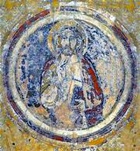

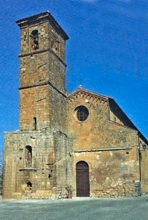
The first church of San Giovenale was probably built here soon after the re-population of Orvieto in the 6th century. Archeological finds on the site in the 19th century (now lost) suggest that it had been occupied by an Etruscan temple. It is possible that the builders of the original church believed that this temple had been dedicated to Tinia (Zeus or Jove, which translates in Italian as Giove) and that this determined its dedication to San Giovenale. However, it is more likely that it received this dedication in 880, when the stolen relics of St Juvenal of Narni were translated along Via Cassia from Lucca, back to their native city.
According to tradition, local residents from seven noble families (Monaldeschi, Montanari, Salvani, Ranaldini, Conti, Rossi and Marsciano) financed the rebuilding of the church in 1004. It was documented as a parish church in 1028, and it had a college of canons by 1154. By 1170 (the date of the inscription on the high altar that refers to Abbot Guido – see below), the church belonged to a community of monks from an order known as the Hermits of St William (Ordine Guglielmino), and was numbered among the 16 monasteries that comprised its Province of Tuscany. The monks lived in the adjoining monastery until ca. 1248, when they left to join the Premonstratensian canons of nearby Santa Lucia (later Sant' Agostino).
San Giovenale then became a parish church again, and was administered by a small community of canons, although St William of Malavalle (the founder of the Williamite Order) continued to be commemorated in the votive frescoes commissioned for the church into the 15th century.
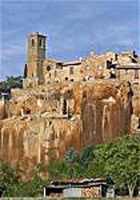
An inscription on the inside of the right pilaster (see the interior) records that Bishop Giuseppe Marsciano re-consecrated the church in 1739. It subsequently became subject to Sant' Agostino and then (from 1810) to the Franciscans who moved there from San Francesco. It passed to the diocese when the Franciscan community was suppressed in 1860.
Exterior
The severe façade survives largely intact, although the small rose window was ruined in the restoration of 1632 (see below). The campanile to the left seems to have been adapted from a defensive tower. Only the lower part of this structure is original; the upper part was rebuilt in its current form in 1825. There are traces of an entrance porch to the left of the campanile, and this was probably removed at the same time.
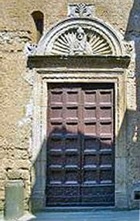
Interior
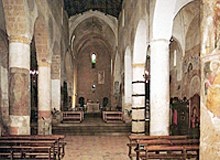
The three bays of the nave nearest the counter-façade survive from the 11th century church. However, its semi-circular apse was demolished in the late 13th century, when the church was extended towards the liturgical east.
-
✴The new extension was built at a higher level than the original, necessitating the flight of four steps at the intersection.
-
✴The last pair of columns were replaced at this point by a pair of pilasters (later frescoed), in order to provide more support for the new vaulting.
-
✴Another small flight of steps leads to the late 13th century square apse.
The church was remodelled in the Baroque style in 1632. The votive frescoes that covered the walls were plastered over at that point, but they were recovered in a recent restoration (see the page given in the link here).
-
✴An inscription on the left wall [where] records the donors who paid for this work, under Prior Francesco Chrisostomi.
-
✴An inscription on the right wall [where] records the demolition of an altar here that had belonged to the Ghezzi family.
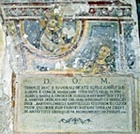
High altar (1170)
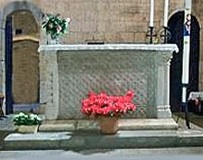
The high altar, which is dedicated to SS Juvenal and Sabinus, reuses a slab of Byzantine interlace (9th century) that probably came from the earlier church. Traces of a ciborium that once rose over the altar have been detected.

Inscriptions on the right side commemorate GUIDO ABAS MCLXX (Abbot Guido, 1170) and above BERNARDUS (who was presumably the sculptor). A marble slab that forms the back of the altar commemorates RAINERUS MONACHUS GEZO, who was presumably the donor and a member of the Ghezzi family (see below).
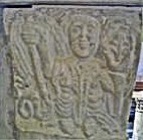
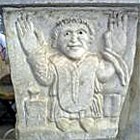
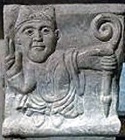
St Michael Abbot Guido (?) St Juvenal
back left capital back left capital back right capital
Three of the capitals have interesting carvings depicting:
-
✴a dove and a griffin (front, left, not illustrated);
-
✴St Michael and a praying abbot, presumably Abbot Guido (back left); and
-
✴St Juvenal (back, right).
Lecterns (late 13th century)
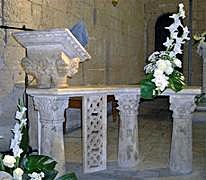
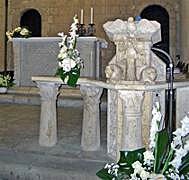
These two lecterns flank the high altar. The one on the right is made up of marble statues of the symbols of the Evangelists, including the eagle of St John that supports the lectern table.
Cappella di Sant' Antonio da Padova
This vaulted chapel is to the right of the apse.
St Antony of Padua (16th century)
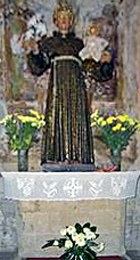
Cappella di San Sabino
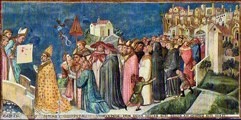
Pope Urban IV meets the Bishop of Orvieto at Ponte di Rio Chiaro
as he returns from Bolsena with the Sacro Corporale
Fresco (1357-64) by Ugolino di Prete Ilario, Cappella del Corporale, Duomo
This chapel to the left of the apse might originally have been the free-standing Oratorio di San Sabino, which was dedicated to St Sabinus of Canosa. This oratory might have been the building to the left of San Giovenale in this fresco (ca. 1364) in the Cappella del Corporale in the Duomo. The cult of St Sabinus was important in San Giovenale: church was actually referred to as SS Giovenale e Sabino in a document of 1314 recording a donation from Cante de’ Gabrielli, Podesta of Orvieto. A reliquary (1340) by Ugolino di Vieri for the skull of St Sabinus (see below) that seems to have been commissioned for this oratory was later displayed in this chapel. The rest of the saints’ relics are said to rest under the tufa altar of the chapel.
Christ and the Evangelists (14th century)
Tomb of Bonuccio Monaldeschi (1350)
This red marble monument is [where ??].
Baptistery

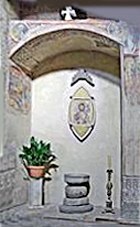

Pavement Ascension (right wall)
The baptistery, houses the font (15th century), is in first bay on left wall, at junction with the counter-facade. The mosaic of St John the Baptist on the back wall is modern.
-
✴The baptistery has lovely carved pavement slabs (9th century) across the entrance.
-
✴The fresco (14th century) on the right wall, which depicts the Ascension of Christ, has been interrupted on the left, showing that the baptistery was originally slightly deeper.
Nave
Tomb of Ugolino Malabranca (died 1374)
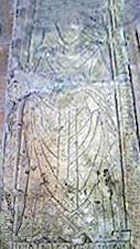
Ugolino Malabranca, who was born in Orvieto, rose to be the General of the Augustinian Hermits and (from 1371) the Latin Patriarch of Constantinople. He died in Acquapendente and was buried in Sant' Agostino, Orvieto. His tomb was moved here in 1884.
Calendar of the Dead (14th century)
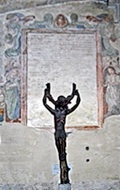
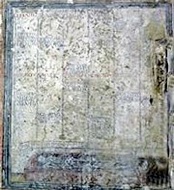
Two frescoes on opposite sides of the nave contain a list of the people for whom Masses are said, arranged by their dates of death.
-
✴The one on the left is behind a wooden Crucifix (14th century).
-
✴The one on the right (to the right of the side entrance) has a frescoed skeleton beneath it.
Other Works of Art
Maestà (15th century)
Madonna and Child enthroned with saints (17th century)
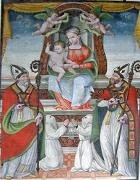
Art from the Church
Reliquary of St Sabinus (ca. 1340)
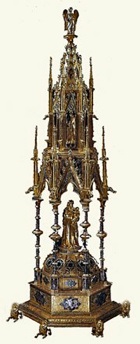
The cranium of the saint is housed under the cupola above the hexagonal base of the reliquary. Three golden figures adorn the higher registers::
-
✴the Madonna and Child stand above the cupola;
-
✴St Sabinus stands in the register above it; and
-
✴an angel at the top, which was added in the second half of the 19th century to replace an earlier figure.
The six enamels in the base depict scenes from the life of St Sabinus.
St Sabinus Altarpiece (1473)
This altarpiece, which is dated by inscription, was documented in the Oratorio di San Savino in Palazzo Carvajal (which was then called Palazzo Pietrangeli) in 1829, and was first attributed to Giovanni Boccati in 1866. A document in the archives of Orvieto records that Antonio Simoncelli made a payment to Giovanni Boccati in 1473, and this almost certainly relates to this altarpiece.
The altarpiece was placed on the art market in Florence in 1895.
-
✴The main panel and the original frame (minus the predella panel) were sold to the Szpmvszeti Muzeum (Museum of Fine Arts), Budapest.
-
•The panel itself depicts the Madonna and Child enthroned, with SS Juvenal, Sabinus of Canosa, Augustine and Jerome, against a gold background. There are two standing angels on each side of the Madonna, and two sit on the marble pavement at her feet, playing stringed instruments. The face of the Madonna seems to have been repainted later in the 15th century, perhaps by Antonio del Massaro da Viterbo, il Pastura.
-
•The upper cornice of the frame contains three painted angels with garlands, and there is a figure of Christ the Redeemer in the lunette above.
-
✴The predella panels depict four scenes from the life of St Sabinus:
-
•St Sabinus talking to his friend, St Benedict on Monte Cassino about Totila's entry into Rome (now in the Museo Thyssen-Bornemisza, Madrid);
-
•St Sabinus recognises Totilla (once in the Mario Lanfranchi collection, Rome);
-
•the Archdeacon Vindemius attempts to poison St Sabinus (now in the Galleria Nazionale, Urbino); and
-
•death of St Sabinus (once in the Spiridon collection, Paris).
There is some confusion as to the original location of the altarpiece:
-
✴Some sources indicate that it came a chapel in the Duomo that was dedicated to St Sabinus of Canosa, but there is no record that any such chapel ever existed.
-
✴More recent scholars suggest that it was painted for the Oratorio di San Savino in Palazzo Carvajal. Cardinal Girolamo Simoncelli, the son of Antonio Simoncelli, built the palace in 1548, and Caravajal dei Caravajal-Simoncelli built the oratory in 1571. It is possible that an earlier palace and oratory on this site belonged to the Simoncelli family at the time that the altarpiece was commissioned.
-
✴A more likely candidate for its original location seems to me to be San Giovenale, near Palazzo Carvajal, given that:
-
•the altarpieces features St Juvenal as well as St Sabinus;
-
•San Giovenale contained relics of St Sabinus and was documented as SS Giovenale e Sabino in 1314; and
-
•St Sabinus features in a number of other works in the church; and
-
•one of the above is a second altarpiece (ca. 1490) with the Madonna and Child enthroned an SS Juvenal, Sabinus of Canosa, with three scenes from the life of St Juvenal in its predella (see below).
-
It is possible that Antonio Simoncelli commissioned the altarpiece for the church, and that it reverted to his descendants before 1807, when Palazzo Carvajal was sold to the Pietrangeli family.
St Juvenal Altarpiece (ca. 1490)
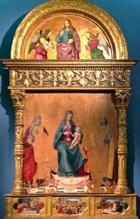
-
✴Christ blessing with angels, in the lunette;
-
✴the Madonna and child enthroned against a gold background, with (now ruined) figures of SS Juvenal and Sabinus to the sides; and
-
✴three scenes from the life of St Juvenal in the predella:
-
•Pope Damasus consecrates St Juvenal as Bishop of Narni;
-
•St Juvenal preaches Narni; and
-
•a pagan commits suicide after he has assaulted St Juvenal.
The main panel is attributed to Jacopo Ripanda da Bologna, who is documented in the Duomo in 1485-95. Members of the workshop that he directed in the Duomo at this time seem also to have been involved:
-
✴the lunette is attributed to Antonio del Massaro da Viterbo, il Pastura, who in the workshop in 1489-92; and
-
✴the predella panels are attributed to Giovanni Francesco d' Avanzarano, il Fantastico, who was documented in the workshop in 1490.
Read more:
V. Benucci, “L’ Antica Chiesa di San Giovenale in Orvieto”, (2000) Orvieto (available in the church)
Proceed to Votive Frescoes.
Return to Monuments of Orvieto.
Return to Walk II.
